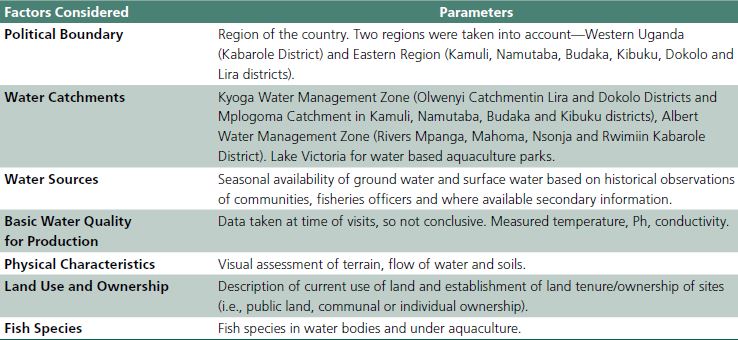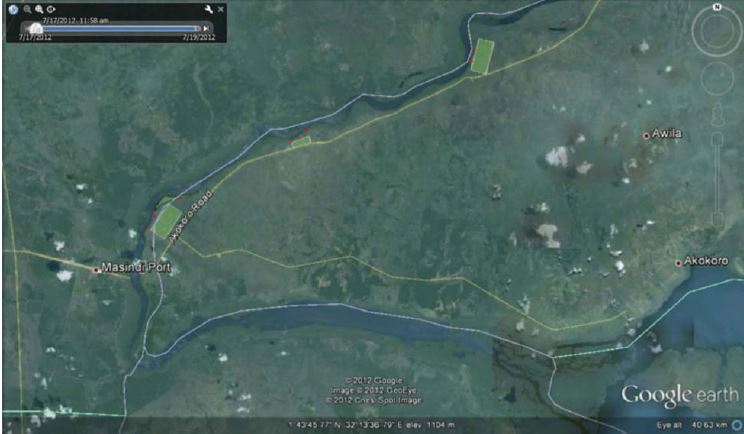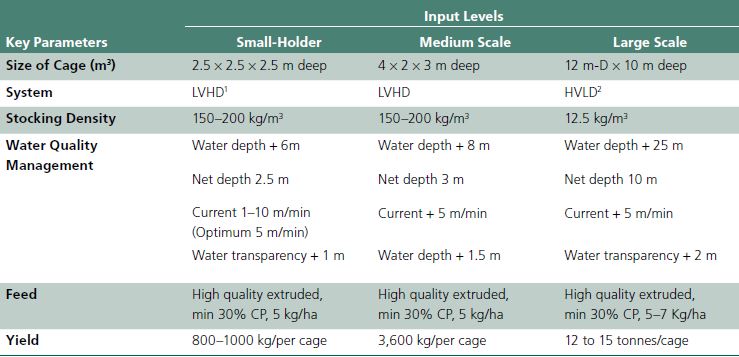4 Site selection for Aquaculture Parks
The information above in addition to site specific measurements of water quality was used to select potential sites for aquaculture parks. Two sites, one for ponds by the River Nile downstream of Lake Kyoga and the other for cages in Lake Victoria close to Bugala Island were thus identified.
4.1 Aquaculture Parks for Fish Ponds
pilot sites for aquaculture parks for fish ponds in Apac district along the Kyoga Nile. The site is within the Kyoga Water Management Zone and is part of the Olwenyi Catchment. It has access to the Great North Road from this site and is also possible from Masindi port. Potential areas for aquaculture parks for fish ponds are presented in Figure 5.
4.2 Aquaculture Parks for Lake Fish Cages
The following were key suitability considerations measured to determine the site locations of aquaculture parks for fish cages:
• Sufficient water column depth, to allow wastes and leftover food to settle and decompose at safe distance without causing competition for oxygen between the cultured fish and the decomposition bacteria. A cage depth to water column depth ratio of 1:3 is ideal.
• A water current flow rate that will effectively wash fish wastes and un-eaten food through and out of the cage at a rate such as to constantly maintain the optimum water quality balance for best production results. A water current flow rate of 1 to 6 meters per minute is usually effective in delivering optimum production results.
• A consistent supply of naturally occurring dissolved oxygen at such concentration levels as to support the high fish densities that are characteristic of cage culture. 5mg of dissolved oxygen per litre of water
Table 5. Summary of scoping site appraisals for fish ponds for Aquaculture Park sites in Uganda.

Adpated from MAAIF (2013).
Figure 5. Potential areas for Aquaculture Parks for fish ponds in Apac.

Source: MAAIF/EU (2013).
and above, at water temperatures between 28–30oC is ideal.
• Turbidity levels, secchi disc readings of between 80–200 cm, to ensure a biomass balance in favour of the cage farming activities and at the same time keeping environmental impact in check.
• Water alkalinity and hardness above 20 mg/l in order to ensure water pH within safe range for fish life sustainability.
In addition to the general requirements for water based aquaculture establishment, the following were taken into account in view of the fact that an Aquaculture Park would be a large commercial entity:
Close proximity to land for the establishment of:
• Fish landing facilities;
• Construction of support facilities such as a hatchery and/or nursery, feed store, net making and mending workshop among others;
• Proximity to marketing outlet complete with one or more quality maintenance and preservation infrastructures such as an ice machine, a cold room and live fish handling facility;
• Access to industry support infrastructure, mainly electricity and good transport network;
• Community perceptions and activities.
Based on the initial identification of potential sites for aquaculture undertaken by NAFIRRI, the best lake based site and the best river based sites were chosen for further analysis. The site survey team visited these areas and further undertook basic site suitability survey including topography, bathymetry, water current speed and direction, water temperature, transparency. At the same time the land ownership issues were ascertained.
As a result of this process, three potential sites within Apac district by the Nile River were identified and the best site chosen for a pond based Aquaculture Park.
The potential sites on Bugala Island were surveyed and the best site identified at Mweena, Kalangala District for cage culture (EU/MAAIF, 2013).
A summary of key parameters for tilapia cage culture is presented in Table 6.
Table 6. Tilapia cage culture options at proposed Mweena Aquaculture Parks site within Lake Victoria.

Note: LVHD1—Low Volume High Density; HVLD2—High Volume Low Density. Source: EU/ MAAIF (2013).